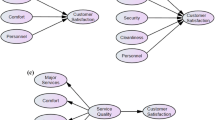Abstract
Supplying public transport systems with high levels of service quality is fundamental for retaining users and attracting new ones. Policies that improve transit service quality will ultimately lead to more sustainable travel patterns. Measuring overall service quality implies measuring the quality of several specific attributes and is prevalently evaluated through the perceptions of users, using satisfaction rates. In this study, we demonstrate that there is a further element that can influence users’ perceptions, the so-called critical incidents (CI), defined as encounters that are particularly satisfying or dissatisfying. The concept is not restricted to ratings of the predefined product or service attributes, because customers who experience CI remember them well and can usually describe the experience. We implement a framework that includes CI and is innovative for several reasons. Firstly, we introduce attribute-specific (e.g. reliability, safety, comfort) CI to explain attribute-specific satisfaction levels, and then we model these with latent constructs allowing for measurement error in recalling the CI. We also demonstrate that using an Ordinal-Probit approach leads to more accurate results than its numerical counterpart, the latter possibly presenting biased results. Finally, we present a full Structural Equation Multiple Cause Multiple Indicator (SEM-MIMIC) model, which corrects for heterogeneity in the perceptions of users regarding satisfaction with the various service attributes, with the overall service, and with loyalty. For these purposes, we analyse an extensive database (96,763 interviewed passengers) derived from Customer Satisfaction Surveys in the railway services offered in the hinterland of Milan. Our main contribution to the literature is that we show that the occurrence of a CI has a substantial negative impact on passenger satisfaction for all service attributes. As it is a policy-related variable, it can be managed directly by the public transport (PT) administrators. To better plan and improve PT services, avoiding CI in specific items should be the strategy to follow. On the other hand, reliability, and added-value services are the primary service attributes that have a positive effect on satisfaction with the overall service and, in turn, on loyalty. Our model can be useful for PT administrators as it sheds light on how to improve the service according to users’ preferences, and by considering the differences among user categories.


Similar content being viewed by others
References
Allen, J., Muñoz, J.C., Ortúzar, J.D.: Modelling service-specific and global transit satisfaction under travel and user heterogeneity. Transp. Res. Part A Policy Pract. 113, 509–528 (2018)
Anderson, J.C., Gerbing, D.W.: Structural equation modeling in practice: a review and recommended two-step approach. Psychol. Bull. 103, 411–423 (1988)
Backhaus, K., Bauer, M.: The impact of critical incidents on customer satisfaction in business-to-business relationships. J. Bus. Bus. Mark. 8(1), 25–54 (2001)
Bitner, M.J., Booms, B.H., Tetreault, M.S.: The service encounter: diagnosing favorable and unfavorable incidents. J. Mark. 54, 71–84 (1990)
Bollen, K.A.: Structural Equations with Latent Variables. Wiley, Chichester (1989)
Bowen, N.K., Guo, S.: Structural Equation Modelling. Oxford University Press, Oxford (2012)
Cadotte, E.R., Turgeon, N.: Dissatisfiers and satisfiers: suggestions for consumer complaints and compliments. J. Consum. Satisf. Dissatisf. Complain. Behav. 1, 74–79 (1988)
Currie, G., Delbosc, A.: An empirical model for the psychology of deliberate and unintentional fare evasion. Transp. Policy 54, 21–29 (2017). https://doi.org/10.1016/j.tranpol.2016.11.002
Dell’Olio, L., Bordagaray, M., Ibeas, A., Cecín, P.: Modelling user perception of bus transit quality considering user and service heterogeneity. Transp. A Transp. Sci. 10, 388–397 (2010)
De Oña, R., Eboli, L., Mazzulla, G.: Key factors affecting rail service quality in the Northern Italy. A decision tree approach. Transport 29, 75–83 (2014). https://doi.org/10.3846/16484142.2014.898216
De Oña, J., de Oña, R., Eboli, L., Mazzulla, G.: Heterogeneity in perceptions of service quality among groups of railway passengers. Int. J. Sustain. Transp. 9, 612–626 (2015)
De Oña, J., de Oña, R., Eboli, L., Mazzulla, G.: Index numbers for monitoring transit service quality. Transp. Res. Part A Policy Pract. 84, 18–30 (2016a)
De Oña, J., de Oña, R., Eboli, L., Forciniti, C., Mazzulla, G.: Transit passengers’ behavioural intentions: the influence of service quality and customer satisfaction. Transp. A 12, 385–412 (2016b)
Diamantopoulos, A., Siguaw, J.A.: Introducing LISREL. Sage Publications, London (2000)
DiStefano, C., Morgan, G.B.: A comparison of diagonal weighted least squares robust estimation techniques for ordinal data. Struct. Equ. Model. Multidiscip. J. 21, 425–438 (2014). https://doi.org/10.1080/10705511.2014.915373
Eboli, L., Mazzulla, G.: Relationships between rail passengers’ satisfaction and service quality: a framework for identifying the key service factors. Public Transp. Plan. Oper. 7, 185–201 (2015)
Edvardsson, B.: Service breakdowns: a study of critical incidents in an airline. Int. J. Serv. Ind. Manag. 3, 17–29 (1992)
Edvardsson, B.: Causes of customer dissatisfaction-studies of public transport by the critical-incident method. Manag. Serv. Qual. 8, 189–197 (1998)
Edvardsson, B., Strandvik, T.: Is a critical incident critical for a customer relationship? Managing Service Quality 10, 82–91 (2000)
Fellesson, M., Friman, M.: Perceived satisfaction with public transport service in nine European cities. J. Transp. Res. Forum 47, 93–103 (2012)
Flanagan, J.C.: The critical incident technique. Psychol. Bull. 51, 327–357 (1954)
Friman, M., Edvardsson, B., Garling, T.: Perceived quality of public transport service: inferences from complaints and negative critical incidents. J. Public Transp. 2, 69–91 (1998)
Friman, M., Edvardsson, B., Garling, T.: Frequency of negative critical incidents and satisfaction with public transport services. J. Retail. Consum. Serv. 8, 95–104 (2001)
Golob, T.F.: Structural equation modeling for travel behavior research. Transp. Res. Part B Methodol. 37, 1–25 (2003). https://doi.org/10.1016/S0191-2615(01)00046-7
Gremler, D.D.: The critical incident technique in service research. J. Serv. Res. 7, 65–89 (2004)
Gremier, D.D., Gwinner, K.P.: Rapport-building behaviours used by retail employees. J. Retail. 84, 308–324 (2008)
Grison, E., Gyselinck, V., Burkhardt, J.M.: Using the critical incidents technique to explore variables related to users’ experience of public transport modes. In: Proceedings of the 31st European Conference on Cognitive Ergonomics, Toulouse, France, August 26–28 (2013)
Guirao, B., García-Pastor, A., López-Lambas, M.E.: The importance of service quality attributes in public transportation: narrowing the gap between scientific research and practitioners’ needs. Transp. Policy 49, 68–77 (2016). https://doi.org/10.1016/j.tranpol.2016.04.003
Hooper, D., Coughlan, J., Mullen, M.: Structural equation modeling: guidelines for determining model fit. Electron. J. Bus. Res. Methods 6, 53–60 (2008)
Hu, L., Bentler, P.M.: Cutoff criteria for fit indexes in covariance structure analysis: conventional criteria versus new alternatives. Struct. Equ. Model. Multidiscip. J. 6, 1–55 (1999). https://doi.org/10.1080/10705519909540118
Jolliffe, I.: Principal component analysis. In: Balakrishnan, N., Colton, T., Everitt, B., Piegorsch, W., Ruggeri, F., Teugels, J.L. (eds.) Wiley StatsRef: Statistics Reference Online. Wiley, Hoboken (2014)
Joreskog, K.G., Goldberger, A.S.: Estimation of a model with multiple indicators and multiple causes of a single latent variable. J. Am. Stat. Assoc. 70, 631–639 (1975). https://doi.org/10.2307/2285946
Kaiser, H.F.: The application of electronic computers to factor analysis. Educ. Psychol. Measur. 20, 141–151 (1960). https://doi.org/10.1177/001316446002000116
Likert, R.: A technique for the measurement of attitudes. Arch. Psychol. 22, 5–55 (1932). http://psycnet.apa.org/record/1933-01885-001
Morton, C., Caulfield, B., Anable, J.: Customer perceptions of quality of service in public transport: evidence for bus transit in Scotland. Case Stud. Transp. Policy 4, 199–207 (2016)
Oliver, R.L.: Satisfaction: A Behavioral Perspective on the Consumer. M.E. Sharpe, Armonk (2010). https://doi.org/10.1108/09564231011066132
Olsen, M.J.S.: The critical episode model as a tool for organizational learning in service organizations. In: Edvardsson, Bo, Modell, Sven (eds.) Service Management. Stockholm, Nerenius and Santérus Förlag Ab (1996)
Olsen, S.O.: Repurchase loyalty: the role of involvement and satisfaction. Psychol. Mark. 24, 315–341 (2007)
Paulssen, M., Birk, M.M.: Satisfaction and repurchase behavior in a business-to-business setting: investigating the moderating effect of manufacturer, company and demographic characteristics. Ind. Mark. Manage. 36, 983–997 (2007). https://doi.org/10.1016/j.indmarman.2007.05.011
Roos, I.: Switching processes in customer relationships. J. Serv. Res. 2, 68–85 (1999)
Roos, I.: Methods of investigating critical incidents: a comparative review. J. Serv. Res. 4, 193–204 (2002)
Rosseel, Y.: Lavaan: an R package for structural equation modelling. J. Stat. Softw. (2012). https://doi.org/10.18637/jss.v048.i02
Stauss, B., Hentschel, B.: Attribute-based versus incident-based measurement of service quality: results of an empirical study in the German car service industry. In: Kunst, P., Lemmink, J. (eds.) Quality Management in Services. Van Gorcum, Assen/Maastricht (1992)
Stauss, B., Weinlich, B.: Process-oriented measurement of service quality. applying the sequential incident method. Eur. J. Mark. 31, 33–55 (1997)
Sundling, C., Nilsson, M.E., Hellqvist, S., Pendrill, L.R., Emardson, R., Berglund, B.: Travel behaviour change in old age: the role of critical incidents in public transport. Eur. J. Ageing 13, 75–83 (2016)
UNI 11098: Linee guida per la rilevazione della soddisfazione del cliente e per la misurazione degli indicatori del relativo processo (2003)
van der Waerden, P.J.H.J., Timmermans, H.J.P.: Key events and critical incidents influencing transport mode switching behavior—an exploratory study. In: Proceedings of the 82nd Annual Meeting of the Transportation Research Board (2003)
van Doorn, J., Verhoef, P.C.: Critical incidents and the impact of satisfaction on customer share. J. Mark. 72(4), 123–142 (2008). https://doi.org/10.1509/jmkg.72.4.123
Wong, A., Sohal, A.: A critical incident approach to the examination of customer relationship management in a retail chain an exploratory study. Qual. Mark. Res. Int. J. 6, 248–262 (2003)
Acknowledgements
We wish to thank the financial support provided by the Centre for Sustainable Urban Development (CEDEUS), CONICYT/FONDAP/15110020, the Bus Rapid Transit Centre of Excellence (BRT+) funded by the Volvo Research and Educational Foundations (VREF), FONDECYT 1150657 and the Institute for Complex Engineering Systems (FONDECYT FB0816). The first author thanks the Chilean Comisión Nacional de Investigación Científica y Tecnológica (CONICYT), Universidad de Costa Rica and the Laboratorio Nacional de Materiales y Modelos Estructurales (LanammeUCR) for partially funding his doctoral studies through the Becas de Doctorado en Chile Año Académico 2015 scholarship the former, and Beca de Estudios de Posgrado en el Exterior 2014 scholarship, the latter two, respectively. This paper was produced while the first author did a six-month stay at Università della Calabria, Italy.
Author information
Authors and Affiliations
Contributions
J. Allen: Content Planning, Literature Search and Review, Modelling, Manuscript Writing; L. Eboli: Content Planning, Literature Search and Review, Survey Design, Manuscript Writing; G. Mazzulla: Content Planning, Literature Search and Review, Survey Design, Manuscript Writing; J. de D. Ortúzar: Content Planning, Manuscript Writing and Editing.
Corresponding author
Ethics declarations
Conflict of interest
On behalf of all authors, the corresponding author states that there is no conflict of interest.
Appendices
Appendix 1
Appendix 2
See Table 8.
Appendix 3
See Table 9.
Appendix 4
Rights and permissions
About this article
Cite this article
Allen, J., Eboli, L., Mazzulla, G. et al. Effect of critical incidents on public transport satisfaction and loyalty: an Ordinal Probit SEM-MIMIC approach. Transportation 47, 827–863 (2020). https://doi.org/10.1007/s11116-018-9921-4
Published:
Issue Date:
DOI: https://doi.org/10.1007/s11116-018-9921-4




